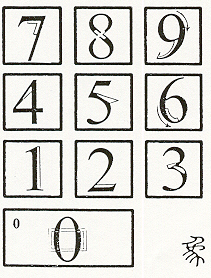Unified Method* to Input
Oriental Languages


中文信息技術 |
中文資訊 |
中文資訊 |
中文資訊 |


 CODE chart CheongChi EXAMPLEs - showing how a character is DI-SECTED |
 CODE chart |
| 倉頡 | 大易 | 五筆 | 鄭碼 |

注音 ZuYin |

So long as
"Microsoft PinYin", come out to meet WORLDWIDE users' need!
Chinese PinYin is an ISOLATED case |
 |







![]()
Japanese GANA 10-key Keyboard

Korean Hanguel 10-key Keyboard
Chinese |
Japanese |
Korean |
 |
 |
 |
 |
 |
 |
傳統中文,每個字都是「有邏輯」的。
讓人 "自己作有系統地" 去「思索」:
權衡輕重。
所以,無論採用什麼教育系統,中國兒童都是聰敏的!
這就是為什麼「 五、七千年來,中華民族從不衰亡的原因。」
Chinese
中 文
Every traditional Chinese character is a "logical identity".
It gives "hint" to lead people "think critically".
按步就班,
邏輯(Logic)訓練,自幼認「字塊」時就已開始。
Step by step,
Weigh it critically.
"Logic Training" starts early in pre-school.
無人能「長久愚弄」他們!
Therefore, no matter what education system adopted in whatever
polical system Chinese children are always "clever".
They can not be FOOLED easily!
This is WHY Chinese is always an important player
in the past 5,000 to 7,000 years!
Population: 1.4 Billion
Chinese
平假名(GANA):
与
片假名(KANA):
唐朝: 618 - 907
HANGUEL 係於十六世紀時,由「天、地、人、和」觀念發展出來。
。 天
(加多一筆,再加多一筆,"再,再" ………)
Japanese
日 文
係由中文 "全字"「草書」發展出來,音同漢字。
Each letter is carefully derived out from a "whole" character's cursive writing.
It sounds exactly as that of the corresponding character.
係由中文「楷書」"局部" 發展出來,音同漢字。
Each letter is only a "portion / slightly deformed portion" of a traditional character.
It sounds exactly as that of the corresponding character.
音: 近江蘇 蘇州音漢 字 KanJi
姓、名、及 重要文意 用
It sounds exactly as that of the corresponding character.
Population: 128 Million
Korean
朝、韓 文
─ 地
l 人
合 和 漢 字 HanJa
姓、名、及 重要文意 用
It sounds exactly as that of the corresponding character.Population: South 49 Million North 23 Million


(I) Western Letters
西 方 文 字(II) Chinese Letters
東 方 文 字
It happened in 8th century, some 700 years before Europe.